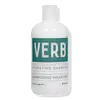What's inside
What's inside
 Key Ingredients
Key Ingredients

No key ingredients
 Benefits
Benefits

No benefits
 Concerns
Concerns

 Ingredients Side-by-side
Ingredients Side-by-side

Water
Skin ConditioningSodium Lauroyl Methyl Isethionate
CleansingCocamidopropyl Betaine
CleansingSodium Lauroyl Sarcosinate
CleansingPPG-2 Hydroxyethyl Coco/Isostearamide
Argania Spinosa Kernel Oil
EmollientAloe Barbadensis Leaf Juice
Skin ConditioningHydrolyzed Quinoa
Skin ConditioningHydrolyzed Vegetable Protein Pg-Propyl Silanetriol
Skin ConditioningHelianthus Annuus Seed Extract
Skin ConditioningAlanine
MaskingArginine
MaskingAspartic Acid
MaskingGlycine
BufferingHistidine
HumectantIsoleucine
Skin ConditioningPhenylalanine
MaskingProline
Skin ConditioningSerine
MaskingThreonine
Valine
MaskingPanthenol
Skin ConditioningGlycol Distearate
EmollientSodium Cocoyl Isethionate
CleansingPEG-150 Pentaerythrityl Tetrastearate
EmulsifyingParfum
MaskingCitric Acid
BufferingSilicone Quaternium-8
Trisodium Ethylenediamine Disuccinate
Guar Hydroxypropyltrimonium Chloride
Skin ConditioningTetrasodium Glutamate Diacetate
Polyquaternium-7
Glycerin
HumectantSodium Laurate
CleansingDisodium EDTA
Polyquaternium-44
Coconut Acid
CleansingSodium PCA
HumectantSodium Lactate
BufferingSodium Isethionate
CleansingMagnesium Nitrate
PCA
HumectantSodium Sarcosinate
Ethylhexylglycerin
Skin ConditioningTrimethylsiloxyamodimethicone
Sodium Hydroxide
BufferingSodium Glycolate
BufferingC11-15 Pareth-7
EmulsifyingSodium Formate
BufferingQuaternium-95
UV AbsorberC12-16 Pareth-9
EmulsifyingPropanediol
SolventTrideceth-12
EmulsifyingPhenoxyethanol
PreservativeSodium Benzoate
MaskingMethylchloroisothiazolinone
PreservativeMethylisothiazolinone
PreservativeBenzyl Alcohol
PerfumingPotassium Sorbate
PreservativeHydroxycitronellal
PerfumingButylphenyl Methylpropional
PerfumingLimonene
PerfumingWater, Sodium Lauroyl Methyl Isethionate, Cocamidopropyl Betaine, Sodium Lauroyl Sarcosinate, PPG-2 Hydroxyethyl Coco/Isostearamide, Argania Spinosa Kernel Oil, Aloe Barbadensis Leaf Juice, Hydrolyzed Quinoa, Hydrolyzed Vegetable Protein Pg-Propyl Silanetriol, Helianthus Annuus Seed Extract, Alanine, Arginine, Aspartic Acid, Glycine, Histidine, Isoleucine, Phenylalanine, Proline, Serine, Threonine, Valine, Panthenol, Glycol Distearate, Sodium Cocoyl Isethionate, PEG-150 Pentaerythrityl Tetrastearate, Parfum, Citric Acid, Silicone Quaternium-8, Trisodium Ethylenediamine Disuccinate, Guar Hydroxypropyltrimonium Chloride, Tetrasodium Glutamate Diacetate, Polyquaternium-7, Glycerin, Sodium Laurate, Disodium EDTA, Polyquaternium-44, Coconut Acid, Sodium PCA, Sodium Lactate, Sodium Isethionate, Magnesium Nitrate, PCA, Sodium Sarcosinate, Ethylhexylglycerin, Trimethylsiloxyamodimethicone, Sodium Hydroxide, Sodium Glycolate, C11-15 Pareth-7, Sodium Formate, Quaternium-95, C12-16 Pareth-9, Propanediol, Trideceth-12, Phenoxyethanol, Sodium Benzoate, Methylchloroisothiazolinone, Methylisothiazolinone, Benzyl Alcohol, Potassium Sorbate, Hydroxycitronellal, Butylphenyl Methylpropional, Limonene
 Reviews
Reviews

Ingredients Explained
These ingredients are found in both products.
Ingredients higher up in an ingredient list are typically present in a larger amount.
Citric Acid is an alpha hydroxy acid (AHA) naturally found in citrus fruits like oranges, lemons, and limes.
Like other AHAs, citric acid can exfoliate skin by breaking down the bonds that hold dead skin cells together. This helps reveal smoother and brighter skin underneath.
However, this exfoliating effect only happens at high concentrations (20%) which can be hard to find in cosmetic products.
Due to this, citric acid is usually included in small amounts as a pH adjuster. This helps keep products slightly more acidic and compatible with skin's natural pH.
In skincare formulas, citric acid can:
While it can provide some skin benefits, research shows lactic acid and glycolic acid are generally more effective and less irritating exfoliants.
Most citric acid used in skincare today is made by fermenting sugars (usually from molasses). This synthetic version is identical to the natural citrus form but easier to stabilize and use in formulations.
Read more about some other popular AHA's here:
Learn more about Citric AcidParfum is a catch-all term for an ingredient or more that is used to give a scent to products.
Also called "fragrance", this ingredient can be a blend of hundreds of chemicals or plant oils. This means every product with "fragrance" or "parfum" in the ingredients list is a different mixture.
For instance, Habanolide is a proprietary trade name for a specific aroma chemical. When used as a fragrance ingredient in cosmetics, most aroma chemicals fall under the broad labeling category of “FRAGRANCE” or “PARFUM” according to EU and US regulations.
The term 'parfum' or 'fragrance' is not regulated in many countries. In many cases, it is up to the brand to define this term.
For instance, many brands choose to label themselves as "fragrance-free" because they are not using synthetic fragrances. However, their products may still contain ingredients such as essential oils that are considered a fragrance by INCI standards.
One example is Calendula flower extract. Calendula is an essential oil that still imparts a scent or 'fragrance'.
Depending on the blend, the ingredients in the mixture can cause allergies and sensitivities on the skin. Some ingredients that are known EU allergens include linalool and citronellol.
Parfum can also be used to mask or cover an unpleasant scent.
The bottom line is: not all fragrances/parfum/ingredients are created equally. If you are worried about fragrances, we recommend taking a closer look at an ingredient. And of course, we always recommend speaking with a professional.
Learn more about ParfumSodium Benzoate is a preservative. It's used in both cosmetic and food products to inhibit the growth of mold and bacteria. It is typically produced synthetically.
Both the US FDA and EU Health Committee have approved the use of sodium benzoate. In the US, levels of 0.1% (of the total product) are allowed.
Sodium benzoate works as a preservative by inhibiting the growth of bacteria inside of cells. It prevents the cell from fermenting a type of sugar using an enzyme called phosphofructokinase.
It is the salt of benzoic acid. Foods containing sodium benzoate include soda, salad dressings, condiments, fruit juices, wines, and snack foods.
Studies for using ascorbic acid and sodium benzoate in cosmetics are lacking, especially in skincare routines with multiple steps.
We always recommend speaking with a professional, such as a dermatologist, if you have any concerns.
Learn more about Sodium BenzoateSodium cocoyl isethionate is a natural ingredient from coconut oil. It is an ultra gentle cleanser that gives a nice foam without drying the skin or impacting the skin barrier.
The amount of foam created depends on the amount of sodium cocoyl isethionate used in the product.
This ingredient also helps improve the spreadability of a product.
Learn more about Sodium Cocoyl IsethionateWater. It's the most common cosmetic ingredient of all. You'll usually see it at the top of ingredient lists, meaning that it makes up the largest part of the product.
So why is it so popular? Water most often acts as a solvent - this means that it helps dissolve other ingredients into the formulation.
You'll also recognize water as that liquid we all need to stay alive. If you see this, drink a glass of water. Stay hydrated!
Learn more about Water